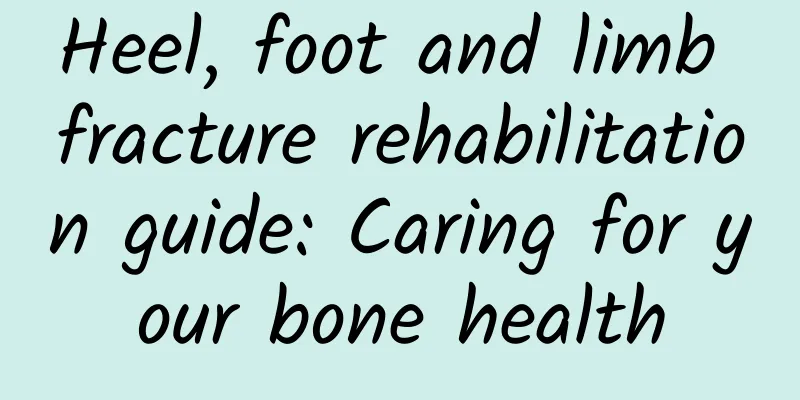Heel, foot and limb fracture rehabilitation guide: Caring for your bone health

|
In our daily lives, we may suffer fractures due to various reasons, such as accidental falls, sports injuries, etc. Fractures are a common traumatic injury, especially fractures of the hands, heels, feet and limbs, which have a great impact on our lives and work. Therefore, it is particularly important to understand the rehabilitation knowledge of fractures and care about our bone health. 1. Definition and classification of fractures Fracture refers to a pathological change in which the continuity of bones is destroyed under the action of external forces. According to the location, shape and degree of fracture, fractures can be divided into the following categories: Classification by location: It can be divided into upper limb fractures (such as humerus, ulna, radius, etc.), lower limb fractures (such as femur, tibia, fibula, etc.) and trunk fractures (such as thoracic vertebrae, lumbar vertebrae, etc.). Classification by morphology: It can be divided into transverse fracture, oblique fracture, spiral fracture, comminuted fracture, etc. Classification by degree: It can be divided into complete fracture (complete break of the bone cortex), incomplete fracture (partial break of the bone cortex) and stable fracture (the fracture ends are stable and not easy to displace), etc. 2. Diagnosis and treatment of fractures Diagnosis: The diagnosis of fracture mainly relies on medical history, physical examination and imaging examination. Medical history mainly includes the injury process, pain site, activity limitation, etc.; physical examination mainly includes observation of local skin, muscles, joints, etc., as well as palpation and percussion, etc.; imaging examination mainly includes X-ray, CT, MRI, etc. Treatment: The treatment principles of fractures are reduction, fixation and functional exercise. Reduction refers to restoring the fracture ends to their normal anatomical position; fixation refers to fixing the fracture ends in a certain position using plaster, splints, brackets, etc. to facilitate healing; functional exercise refers to appropriate rehabilitation training after fracture healing to restore joint mobility and muscle strength. III. Rehabilitation of fractures of hands, heels, feet and limbs Rehabilitation goal: The rehabilitation goal of heel, foot and limb fractures is to restore joint range of motion, muscle strength and daily living ability, and reduce the occurrence of complications. Rehabilitation stage: Rehabilitation of heel, foot and limb fractures is divided into early rehabilitation (1-2 weeks after injury), mid-term rehabilitation (2-6 weeks after injury) and late rehabilitation (after 6 weeks after injury). Early rehabilitation: The main tasks of early rehabilitation are to relieve pain, reduce swelling and stop bleeding, prevent infection and promote blood circulation. Specific measures include: raising the affected limb, cold compress, local massage, drug treatment, etc. In addition, some passive joint movement and muscle contraction training can be performed to prevent joint stiffness and muscle atrophy. Mid-term rehabilitation: The main task of mid-term rehabilitation is to restore joint mobility and muscle strength. Specific measures include: active joint activity training, muscle strength training, balance training, etc. In addition, some functional training can also be performed, such as going up and down stairs, walking, etc., to improve daily living ability. Late rehabilitation: The main task of late rehabilitation is to consolidate the results of early rehabilitation and improve joint stability and muscle endurance. Specific measures include: continuous joint activity training, muscle strength training, balance training, etc. In addition, some aerobic exercise and resistance training can also be performed to improve cardiopulmonary function and muscle endurance. 4. Precautions for fracture rehabilitation Follow your doctor’s advice: When rehabilitating a fracture, it is important to follow your doctor’s advice and instructions to avoid worsening the injury or causing other complications. Gradual progress: Rehabilitation training should proceed from simple to complex, from low intensity to high intensity, and gradually increase the amount and difficulty of training to avoid excessive fatigue or injury. Pay attention to safety: During rehabilitation training, pay attention to the safety of the environment to avoid accidents such as falls or collisions. If necessary, use walking aids or help from others. Diet adjustment: A reasonable diet is helpful for fracture healing and recovery. You should ensure adequate intake of nutrients such as protein, calcium, phosphorus, etc. At the same time, pay attention to controlling calorie intake and avoid obesity. Psychological adjustment: Fracture patients may experience psychological problems such as anxiety and depression. They should actively adjust their mentality and maintain an optimistic and positive attitude to facilitate recovery. In short, the rehabilitation of hand, heel, foot and limb fractures is a long and complicated process that requires the joint efforts of patients and their families. Through scientific rehabilitation methods and reasonable life adjustments, we can restore bone health as soon as possible and return to a better life. V. Conclusion Heel, foot and limb fractures are a common traumatic injury that has a great impact on our lives and work. It is particularly important to understand the knowledge of fracture rehabilitation and care for our bone health. Through scientific rehabilitation methods and reasonable life adjustments, we can restore bone health as soon as possible and return to a better life. I hope this article can provide you with useful information about the rehabilitation of heel, foot and limb fractures, and help you better care for your bone health. |
>>: High-risk factors for colorectal cancer and population screening guidelines
Recommend
Why is two hours of outdoor exercise every day helpful in preventing and controlling myopia?
Natural light: The light intensity in the outdoor...
Swimming on the last day of menstruation
Women's menstruation usually lasts 3-7 days e...
Can you take Pudilan anti-inflammatory oral liquid during breastfeeding?
When you have a cold or are sick, many people cho...
How to read the pregnancy test report
Prenatal check-ups are something mothers should p...
What are the symptoms of breast abscess?
Mastitis is a disease with a relatively high inci...
What causes high blood lipids during menopause?
When women reach menopause, they experience a ser...
Should I wear a bra while breastfeeding?
Breastfeeding mothers are responsible for feeding...
Can pregnant women get anti-inflammatory drips?
When the human body shows more serious cold sympt...
What causes pain on the right side of a woman's lower abdomen?
For many women, stomach pain seems to be a common...
Can microbes also help humans fight cancer? - New therapeutic potential of intestinal flora
Can microbes also help humans fight cancer? - New...
Usage of social networks in China’s fund industry in 2013
Usage of social networks in China’s fund industry...
What to do if pelvic inflammatory disease causes back pain
Pelvic inflammatory disease is a common gynecolog...
Can I eat breakfast before a gynecological examination?
Married women are more likely to suffer from gyne...
International Stomach Protection Day | Receive the stomach care guide to keep your stomach healthy
International Stomach Protection Day is also know...









